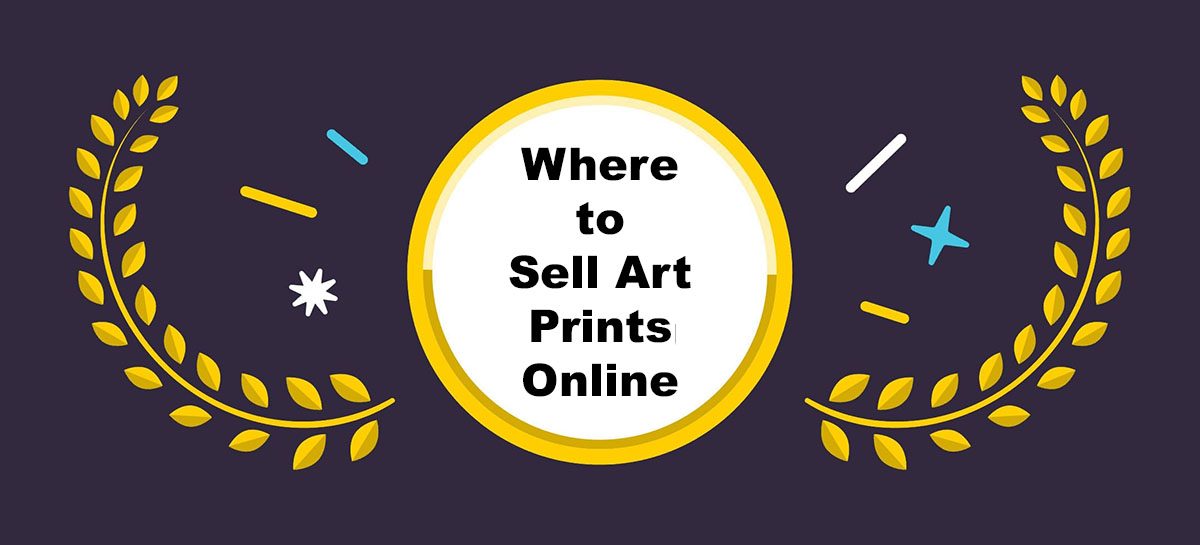The quickest answer?
Start with Redbubble or Society6 if you want easy setup and built-in traffic.
If you’re serious about building your own brand and keeping higher profits, go with Shopify + Printful.
If you’re an artist or designer looking to sell art prints without managing stock or shipping, print on demand is the simplest route.
You upload your work, choose the products, set your price, and the platform handles everything else.
But choosing where to sell — that’s the real challenge. Some platforms give you traffic but low control. Others give you full freedom, but you have to bring in your own audience.
This guide walks you through the best places to sell your art online with print on demand, and helps you figure out which option fits your goals.
TL;DR – Best Places to Sell Art Prints Online (Print on Demand)
- Just want a quick start? Use Redbubble or Society6 for fast setup and built-in traffic.
- Want higher profits and brand control? Use Shopify + Printful or Gelato to run your own store.
- Marketplaces = low effort, lower margins.
Self-hosted stores = more work, more control, more long-term potential. - Best marketplaces:
Redbubble (pop art, stickers)
Society6 (premium wall art)
Fine Art America (traditional/fine art)
Zazzle (custom designs) - Best POD providers for Shopify:
Printful (quality + support)
Gelato (global shipping)
Printify (cheapest base prices) - Want to earn more? Focus on upselling, bundles, and email marketing. Most artists don’t — that’s your edge.
Scroll down for platform comparisons, pricing tips, and step-by-step strategies.
1. Marketplace vs. Self-Hosted: What’s Better for Artists?
When it comes to selling your art prints online using print on demand, there are two main paths to consider: using a marketplace or creating a self-hosted online store.
Each approach comes with its own pros, challenges, and earning potential.
The decision ultimately depends on how much control you want over your brand and how much effort you’re willing to invest in building traffic.
Marketplaces
These are established platforms with their own traffic, audience, and search features. They let you upload your artwork, apply it to different products (like posters, framed prints, canvas), and start selling almost immediately.
Some of the most well-known art marketplaces include:
- Redbubble
- Society6
- Fine Art America
- Zazzle
- TeePublic
Pros of Marketplaces:
- Instant exposure to millions of buyers
- No upfront cost or monthly fees
- No need to manage customer support or logistics
- Faster setup — you can launch in a day
Cons of Marketplaces:
- Lower profit margins (platforms take a cut and set base prices)
- You don’t control the brand or customer data
- Difficult to stand out due to high competition
- Limited ability to build repeat buyers or email lists
Self-Hosted Sites with POD Integrations
This model gives you full control. You create your own online store using platforms like Shopify, WooCommerce, or BigCommerce, and then connect it to a POD service like Printful, Gelato, or Printify to handle fulfilment.
Instead of relying on marketplace algorithms, you’re building your own audience through marketing, SEO, and branding.
Pros of Self-Hosted Stores:
- Own your customer list and data
- Full branding control (custom domains, packaging, upsells)
- Higher profit margins with smart pricing
- Build a long-term business asset
Cons of Self-Hosted Stores:
- Monthly costs for store platform and apps
- You need to generate your own traffic
- Takes more time to build trust and authority
- You’re responsible for customer service and marketing
Quick Comparison Table:
| Feature | Marketplaces | Self-Hosted (Shopify + POD) |
|---|---|---|
| Setup Speed | Fast (same day) | Medium (few days to weeks) |
| Upfront Cost | None | Shopify starts at $39/month |
| Traffic | Provided by platform | You drive it |
| Profit Margins | Low to medium | Medium to high |
| Brand Control | Very limited | Full control |
| Customer Retention | Not possible | Full ownership |
| Best For | Beginners, hobbyists | Professionals, brand-builders |
2. Top Print on Demand Marketplaces for Selling Art Prints
If you’re looking to keep things simple while tapping into an existing audience, print on demand marketplaces can be a solid first step. Each one caters to different types of art, styles, and buyers — so the right fit depends on your work.
Here’s a breakdown of the most relevant platforms for selling art prints:
Redbubble
- Traffic: 30M+ monthly visitors
- Commission: You set your own margin (above fixed base price)
- Ideal For: Digital illustrators, pop art, graphic styles
Pros:
- Easy setup, intuitive interface
- Huge product range (prints, canvas, stickers, etc.)
- Appeals to a younger, design-forward audience
Cons:
- Very competitive space
- Frequent sitewide discounts may affect your margins
Society6
- Traffic: Around 10M monthly visitors
- Commission: Flat 10% for most products; higher % for framed art prints
- Ideal For: Interior design-focused art, minimalist pieces, photography
Pros:
- High-quality printing and presentation
- Aesthetically curated site — great for premium artwork
- Audience expects to pay for quality
Cons:
- More selective with artist acceptance
- Higher base pricing can affect pricing flexibility
Fine Art America
- Traffic: Roughly 5M monthly visitors
- Commission: You set your markup above base prices
- Ideal For: Painters, fine artists, photographers
Pros:
- Offers framing, canvas, acrylic, and museum-quality prints
- Handles global fulfilment, customs, VAT
- Print sizes and formats suited for galleries and exhibitions
Cons:
- Platform design is outdated
- Less effective for digital-only or modern design work
Zazzle
- Traffic: Around 11M monthly visitors
- Commission: You choose royalty (from 5% to 99%)
- Ideal For: Custom designs, personalisable gifts, general creatives
Pros:
- Highly flexible pricing and royalty options
- Huge product catalogue beyond art prints
- Loyal user base for personalised items
Cons:
- Less tailored for fine artists
- Crowded platform with varied quality levels
Comparison Table of POD Marketplaces:
| Platform | Avg. Traffic | Margin Control | Print Quality | Best For |
|---|---|---|---|---|
| Redbubble | 30M+ | You choose | Good | Graphic, pop, youth appeal |
| Society6 | 10M | Limited | High | Home decor, photography |
| Fine Art America | 5M | Full | Very high | Traditional artists |
| Zazzle | 11M | Full | Moderate | Custom gifts, general art |
3. Selling on Shopify With POD Integrations
For artists looking to build a long-term business, owning your own online store is one of the most sustainable options.
You get control over pricing, branding, SEO, and email marketing — all critical for scaling your art print business.
Shopify is the most common platform, thanks to its ease of use and vast plugin ecosystem. You can easily connect it to POD apps that handle the fulfilment behind the scenes.
Top Print on Demand Apps for Shopify
| POD Provider | Strengths | Fulfilment Locations | Art Print Options |
|---|---|---|---|
| Printful | Excellent print quality, live support | US, EU, AUS | Canvas, framed, posters |
| Gelato | Fast shipping, wide reach | 30+ countries | Posters, art prints |
| Printify | Cheapest base cost, variety of partners | Global | Posters, framed prints |
| Gooten | Good for automation and volume | North America | Posters, wall prints |
Why Artists Use Shopify + POD:
- Brand control: You choose how your store looks and feels
- Build an email list: You own your audience, not the platform
- Higher pricing flexibility: Set your margins based on product type
- SEO potential: Rank for keywords like “modern botanical prints”
- Automated fulfilment: Printful, Printify, etc., handle logistics
What You’ll Need to Consider:
- Shopify costs $39/month minimum
- You’ll need to set up payment gateways, tax, and shipping
- Learning curve for digital marketing, SEO, and email tools
- Need to create compelling product pages, collections, and offers
This route takes more time upfront but pays off with higher profits and long-term brand equity.
4. Niche & Emerging POD Platforms for Artists
Besides the large players, there are niche and emerging platforms that focus on unique formats or curated art experiences. These aren’t as high-traffic but offer better alignment for specific styles.
INPRNT
- Artist Approval: Yes — you must apply
- Product Focus: High-quality art prints
- Audience: Art collectors, gallery enthusiasts
- Vibe: Minimalist, serious, curated
Ideal for: Artists with portfolio-ready collections and a strong aesthetic vision.
Displate
- Medium: Metal prints (magnetic mounting)
- Audience: Gamers, tech fans, pop culture fans
- Commission: Up to 41% margin on premium store
- Standout Feature: Unique product format and durable finish
Ideal for: Digital artists, fantasy, sci-fi, comic, anime artwork.
Curioos
- Product Focus: High-end wall art
- Curation: Yes — invite only
- Print Types: Canvas, aluminum, plexiglass
- Audience: Upscale buyers
Ideal for: Artists targeting high-income collectors or interior designers.
5. Profit Margins and Pricing Strategies
When it comes to print on demand, margins are everything. If you’re not pricing your art prints properly, it doesn’t matter how many you sell — you won’t see profit. That’s why understanding the financial side of each platform is just as important as choosing where to sell.
Let’s look at what kind of earnings you can expect and how to structure your pricing to protect your profits without scaring off buyers.
Average Earnings per Platform
Here’s a rough estimate of how much artists typically earn per sale on each POD platform:
| Platform | Avg. Artist Earnings per Print |
|---|---|
| Redbubble | $2 – $6 |
| Society6 | $4 – $10 |
| Fine Art America | $6 – $20+ |
| Shopify + Printful | $10 – $30+ |
| Displate | $15 – $40 |
Note: These are averages. Your final margin depends on your markup, product type, and shipping strategy.
How to Price Your Art Prints for Profit
There’s no single formula, but here are a few things to consider when setting prices:
- Base cost from your POD provider (what they charge to produce and ship)
- Marketplace fees or Shopify subscription
- Desired profit per print
- Shipping (included or added at checkout)
- Competitor pricing in your niche
A safe starting markup is 40-50% above your base cost, but many artists who build strong branding charge much more — especially on framed or limited-edition prints.
Tips to Improve Profit Margins
You don’t need to undercut to make sales. Try these proven strategies to increase earnings per order:
Smart Pricing Techniques
- Charge more for framed prints, large sizes, and canvas — buyers expect to pay more for premium formats
- Bundle deals (e.g. buy 2 prints, get 10% off)
- Limited edition series (create urgency and perceived value)
- Tiered pricing (different price points for different size options)
Reduce Return-Related Losses
- Use detailed product previews (mockups and lifestyle images)
- Add size guides and framing details to reduce order confusion
- Include notes on colours being slightly different in print vs screen
Platform-Specific Tricks
- On Shopify, use upsells (like framing or matching prints) to increase cart value
- On Redbubble and Society6, test different margins — sometimes a 30% markup doesn’t affect sales but adds a lot of profit
Getting pricing right means testing what works with your art style, your audience, and your platform.
6. Marketing Tips to Sell More Art Prints Online
Having great art isn’t enough. Most artists fail with print on demand not because their work isn’t good, but because no one sees it.
If you want consistent sales, you need a strategy to get your prints in front of the right people. The best marketing plans mix organic and paid channels, build community, and keep your audience coming back.
Organic Marketing Strategies
These are free methods that build long-term traffic over time. They require consistency, but they compound.
- One of the best platforms for visual discovery
- Create pins that showcase your art in mockup scenes (bedroom, office, gallery wall)
- Link pins to your POD product pages or Shopify store
- Use searchable keywords like “modern abstract art print” or “boho wall decor”
SEO Content
- Write blog posts targeting buyer intent (e.g., “best wall art for minimalist homes”)
- Use keywords in your product titles, descriptions, and alt tags
- Add meta descriptions that speak directly to the buyer’s taste
Instagram + Reels
- Share behind-the-scenes videos of your process
- Post time-lapses, mockups, packing clips
- Use niche hashtags like #modernartprints or #printsondemandartist
- Link your store in bio — use tools like Linktree to send traffic to multiple collections
Paid Marketing Options
If you’re building a store with Shopify, paid ads can scale traffic faster — if you know your audience.
Instagram & Facebook Ads
- Create carousel ads that showcase your bestsellers
- Target by interests like “interior design,” “home decor,” “wall art lovers”
- Use retargeting for abandoned carts and page viewers
Google Shopping Ads
- Pulls directly from your Shopify product feed
- Works great for very specific product searches
- Bids are lower than Facebook for niche queries like “pink abstract framed print”
Even a $5–$10/day budget can make a difference if your product pages are optimised.
Email Marketing for Artists
One of the biggest advantages of self-hosted stores is being able to build and market to your email list.
Even with marketplaces, you can encourage followers to join your newsletter through social media or packaging inserts.
How to Build an Artist Email List:
- Offer a free digital wallpaper or print in exchange for an email
- Use a pop-up on your Shopify store with an incentive (e.g. 10% off your first print)
- Run giveaways to collect emails quickly
How to Use Your List:
- Send launch announcements for new collections
- Offer time-limited promotions (holiday-themed, new year, back to school, etc.)
- Share behind-the-scenes content or stories about your work
- Highlight customer photos or testimonials
People who subscribe to your email list are far more likely to become repeat buyers, which drastically boosts your revenue per customer over time.
Final Thoughts: Where to Sell Art Print Online?
If you’re just starting out and want the easiest way to test the waters, platforms like Redbubble, Society6, or Fine Art America are great low-risk options.
They handle everything, give you access to millions of potential buyers, and don’t require any upfront cost.
But if your goal is to build a real brand, grow repeat customers, and keep more of your profit, the better long-term move is using Shopify with a print-on-demand service like Printful or Gelato.
It takes more work, but it also gives you full control and higher margins.
There’s no one-size-fits-all solution. Where you sell your art prints online depends on:
- How much time you want to invest
- Whether you want fast exposure or long-term ownership
- How serious you are about turning your art into a business
Whatever you choose, focus on creating high-quality product listings, use mockups that show your prints in real spaces, and market consistently. That’s how you stand out — no matter which platform you’re on.






